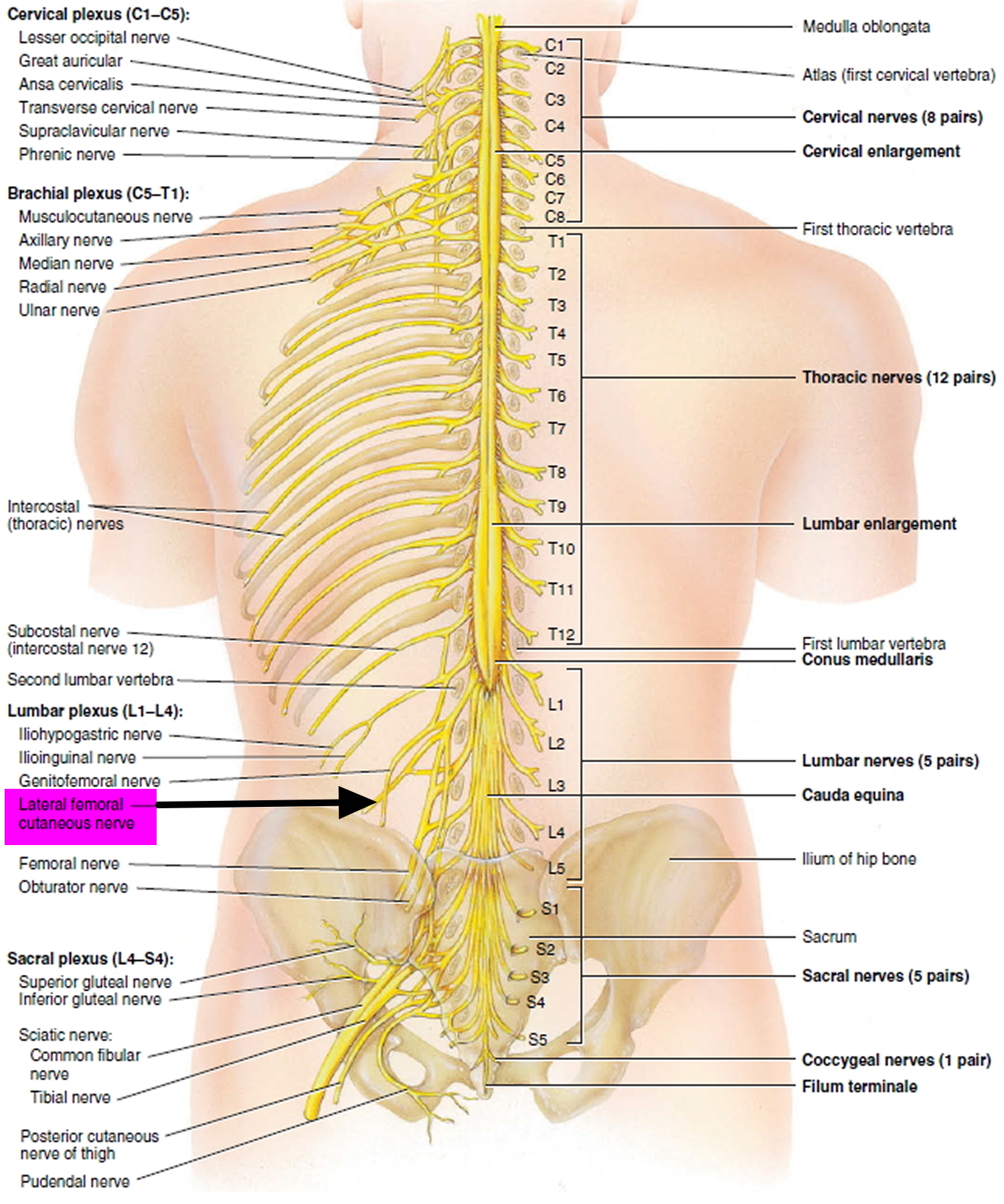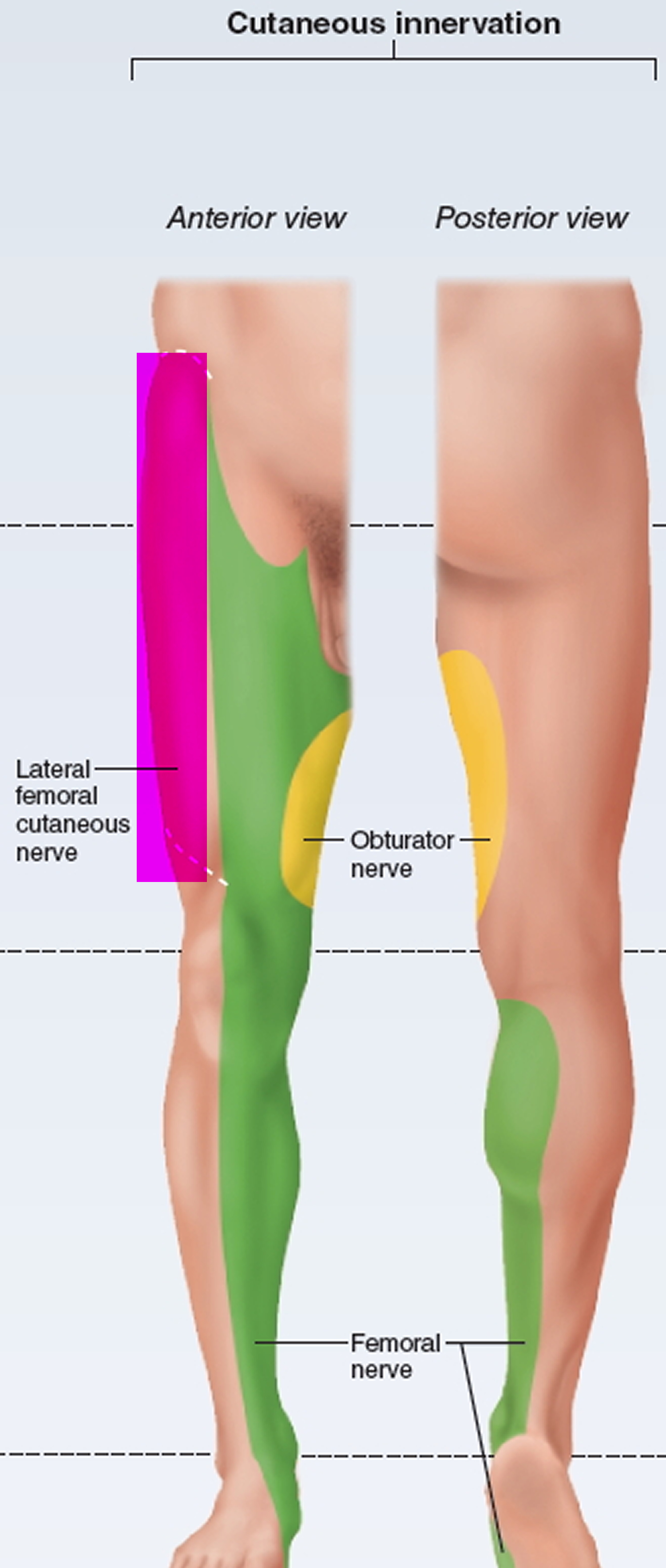Contents
What is meralgia paresthetica
Meralgia paresthetica is a disorder characterized by tingling, numbness, and burning pain in the outer side of the thigh (see Figure 3). The disorder is caused by compression of the lateral femoral cutaneous nerve (spinal nerve ventral rami of L2 and L3), a sensory nerve to the skin (see Figures 1 and 2). Compression may occur next to the spine, within the abdominal cavity, or as the nerve exits the pelvis. The name Meralgia paresthetica is derived from the Greek word meros (thigh) and algos (pain) and was first described in the late 19th century by Martin Bernhardt, a German pathologist 1. People with the disorder often notice a patch of skin that is sensitive to touch and sometimes painful. Meralgia paresthetica should not be associated with weakness or radiating pain from the back.
Tight clothing, obesity or weight gain, and pregnancy are common causes of meralgia paresthetica. However, meralgia paresthetica can also be due to local trauma or a disease, such as diabetes 2. Sometimes a cause is not found.
Although uncommon meralgia parasthetica is not rare, and hence is probably under diagnosed. Meralgia parastehtica has been reported in up as much as 35% of patients referred for assessment of leg discomfort.
The prevalence is estimated to be 3 cases per 10 000 population.The majority of cases occur in individuals between 30-65 years of age, although it has been reported at both extremes of age. In half of the cases, both legs may be affected.
Meralgia paresthetica occurs more commonly in men than women, and is generally found in middle-aged or overweight individuals.
In most cases, you can relieve meralgia paresthetica with conservative measures, such as wearing looser clothing. In severe cases, treatment may include medications to relieve discomfort or, rarely, surgery.
Figure 1. Lateral femoral cutaneous nerve
Figure 2. Lateral femoral cutaneous nerve
Figure 3. Meralgia paresthetica (sensory nerve to the skin supplied by lateral femoral cutaneous nerve)
Meralgia paresthetica causes
Meralgia paresthetica occurs when the lateral femoral cutaneous nerve — which supplies sensation to the surface of your outer thigh — becomes compressed, or pinched. The lateral femoral cutaneous nerve is purely a sensory nerve and doesn’t affect your ability to use your leg muscles.
In most people, this nerve passes through the groin to the upper thigh without trouble. But in meralgia paresthetica, the lateral femoral cutaneous nerve becomes trapped — often under the inguinal ligament, which runs along your groin from your abdomen to your upper thigh.
Common causes of this compression include any condition that increases pressure on the groin, including:
- Tight clothing, such as belts, corsets and tight pants
- Obesity or weight gain
- Wearing a heavy tool belt
- Pregnancy
- Scar tissue near the inguinal ligament due to injury or past surgery
Nerve injury, which can be due to diabetes or seat belt injury after a motor vehicle accident, for example, also can cause meralgia paresthetica.
Risk factors for meralgia paresthetica
The following might increase your risk of meralgia paresthetica:
- Extra weight. Being overweight or obese can increase the pressure on your lateral femoral cutaneous nerve.
- Pregnancy. A growing belly puts added pressure on your groin, through which the lateral femoral cutaneous nerve passes.
- Diabetes. Diabetes-related nerve injury can lead to meralgia paresthetica.
- Age. People between the ages of 30 and 60 are at a higher risk.
Meralgia Paraesthetica Prognosis (Outlook)
Prognosis depends on the cause of the meralgia paraesthetica. If it is caused by something reversible, such as tight clothing, symptoms often recover quickly once this is addressed. The abnormal sensations usually get better over time, but the numbness may persist.
Meralgia paresthetica symptoms
Pressure on the lateral femoral cutaneous nerve, which supplies sensation to your upper thigh, might cause these symptoms of meralgia paresthetica:
- Tingling and numbness in the outer (lateral) part of your thigh
- Burning pain on the surface of the outer part of your thigh
These symptoms commonly occur on one side of your body and might intensify after walking or standing.
Meralgia paresthetica diagnosis
In most cases, your doctor can make a diagnosis of meralgia paresthetica based on your medical history and a physical exam. He or she might test the sensation of the affected thigh, ask you to describe the pain, and ask you to trace the numb or painful area on your thigh. Additional examination including strength testing and reflex testing might be done to help exclude other causes for the symptoms.
To rule out other conditions, your doctor might recommend:
- Imaging studies. Although no specific changes are evident on X-ray if you have meralgia paresthetica, images of your hip and pelvic area might be helpful to exclude other conditions as a cause of your symptoms. If your doctor suspects a tumor could be causing your pain, he or she might order a CT scan or MRI.
- Electromyography. This test measures the electrical discharges produced in muscles to help evaluate and diagnose muscle and nerve disorders. A thin needle electrode is placed into the muscle to record electrical activity. Results of this test are normal in meralgia paresthetica, but the test might be needed to exclude other disorders when the diagnosis isn’t clear.
- Nerve conduction study. Patch-style electrodes are placed on your skin to stimulate the nerve with a mild electrical impulse. The electrical impulse helps diagnose damaged nerves. This test might be done primarily to exclude other causes for the symptoms.
- Nerve blockade. Pain relief achieved from anesthetic injection into your thigh where the lateral femoral cutaneous nerve enters into it can confirm that you have meralgia paresthetica. Ultrasound imaging might be used to guide the needle.
Meralgia paresthetica treatment
For most people, the symptoms of meralgia paresthetica ease in a few months. Treatment focuses on relieving nerve compression.
Meralgia paresthetica relief
Conservative measures include:
- Wearing looser clothing
- Losing excess weight
- Taking OTC pain relievers such as acetaminophen (Tylenol, others), ibruprofen (Advil, Motrin IB, others) or aspirin
Medications
If symptoms persist for more than two months or your pain is severe, treatment might include:
- Corticosteroid injections. Injections can reduce inflammation and temporarily relieve pain. Possible side effects include joint infection, nerve damage, pain and whitening of skin around the injection site.
- Tricyclic antidepressants. These medications might relieve your pain. Side effects include drowsiness, dry mouth, constipation and impaired sexual functioning.
- Gabapentin (Gralise, Neurontin), phenytoin (Dilantin) or pregabalin (Lyrica). These anti-seizure medications might help lessen your painful symptoms. Side effects include constipation, nausea, dizziness, drowsiness and lightheadedness.
Surgery
Rarely, surgery to decompress the nerve is considered. This option is only for people with severe and long-lasting symptoms.
Meralgia paresthetica treatment at home
The following self-care measures can help treat and prevent meralgia paresthetica:
- Avoid wearing tight clothing.
- Maintain a healthy weight, or lose weight if you’re overweight.
- Neuropathologische Beobachtungen. Bernhardt M. Dtsch Arch für Klin Med. 1878;22:362–393[↩]
- Meralgia paresthetica: relation to obesity, advanced age, and diabetes mellitus. Parisi TJ, Mandrekar J, Dyck PJ, Klein CJ. Neurology. 2011 Oct 18; 77(16):1538-42. https://www.ncbi.nlm.nih.gov/pmc/articles/PMC3198972/[↩]








